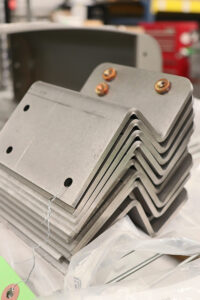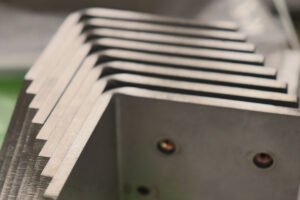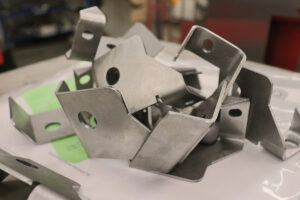 In sheet metal design, the creation of flanges, tabs, and hems is a common technique used to add strength, facilitate assembly, and improve the overall function of a part. When designing these features, it’s essential to carefully consider flange lengths and distances to ensure the part performs as intended, is manufacturable, and meets quality standards. The Machinery’s Handbook (31st Edition) provides comprehensive guidelines on how to design these features effectively to avoid issues such as distortion, improper fit, or difficulty during assembly.
In sheet metal design, the creation of flanges, tabs, and hems is a common technique used to add strength, facilitate assembly, and improve the overall function of a part. When designing these features, it’s essential to carefully consider flange lengths and distances to ensure the part performs as intended, is manufacturable, and meets quality standards. The Machinery’s Handbook (31st Edition) provides comprehensive guidelines on how to design these features effectively to avoid issues such as distortion, improper fit, or difficulty during assembly.
Flange Lengths & Their Role in Sheet Metal Parts
A sheet metal flange is a projecting edge or rim on a part that is used for stiffening, joining, or providing a surface for fasteners. The design of a flange must account for the bend radius, material thickness, and the functional purpose of the flange, whether it is to add strength or allow for the attachment of other components. The length of the flange plays a critical role in determining its strength and effectiveness.
Machinery’s Handbook offers guidelines for determining the minimum and maximum flange lengths based on material type, thickness, and bend radius. Typically, the flange length should be at least 1.5 times the material thickness to ensure adequate strength and prevent buckling under load. The table below, adapted from Machinery’s Handbook, provides typical flange length recommendations:
| Material | Minimum Flange Length | Recommended Flange Length |
|---|---|---|
| Mild Steel | 1.5 x Thickness | 2.0 x Thickness |
| Aluminum | 1.5 x Thickness | 2.0 x Thickness |
| Stainless Steel | 2.0 x Thickness | 2.5 x Thickness |
| Copper | 1.5 x Thickness | 2.0 x Thickness |
A flange that is too short can lead to inadequate support or attachment, while a flange that is excessively long may result in material wastage or unnecessary complexity during fabrication.
Tabs & Hems: Design Considerations
In addition to flanges, tabs and hems are also important features in sheet metal parts. Tabs are small protrusions that are often used for joining or aligning parts, while hems are rolled edges that provide added strength and smoothness to the part’s edges.
- Tabs: When designing tabs, it’s important to ensure they are long enough to provide a secure joint but not so long that they increase the likelihood of part distortion during forming. A common guideline is that the length of a tab should be at least twice the material thickness, though this can vary based on material properties and the specific design requirements.
- Hems: Hems are typically used to reinforce the edges of sheet metal parts and prevent sharp edges. The length of a hem should generally be equal to or slightly greater than the material thickness to provide sufficient strength without introducing excess bulk. Machinery’s Handbook recommends that the minimum hem length should be at least 1.5 times the material thickness for common materials.
Practical Example & Considerations for Design
When designing a sheet metal bracket with a flange, a tab, and a hem, engineers must consider the intended functionality and the manufacturing constraints.
 For example, if you are designing a bracket with a 1/8″ thick mild steel sheet, the flange length should be at least 3/16″ and ideally 1/4″, based on the guidelines from Machinery’s Handbook.
For example, if you are designing a bracket with a 1/8″ thick mild steel sheet, the flange length should be at least 3/16″ and ideally 1/4″, based on the guidelines from Machinery’s Handbook.
The design should also account for ease of manufacturing. Tight corners or complex geometries can complicate the bending process and increase tooling costs, so flanges, tabs, and hems should be designed with manufacturability in mind.
 Correctly designing flange lengths and distances in sheet metal parts is essential for ensuring strength, functionality, and ease of manufacture. By adhering to the guidelines in Machinery’s Handbook and considering the material type, thickness, and intended use, engineers can create reliable and cost-effective designs that are both strong and efficient to produce. Flanges, tabs, and hems are integral to many sheet metal components, and careful attention to their design can make a significant difference in the final product’s quality and performance.
Correctly designing flange lengths and distances in sheet metal parts is essential for ensuring strength, functionality, and ease of manufacture. By adhering to the guidelines in Machinery’s Handbook and considering the material type, thickness, and intended use, engineers can create reliable and cost-effective designs that are both strong and efficient to produce. Flanges, tabs, and hems are integral to many sheet metal components, and careful attention to their design can make a significant difference in the final product’s quality and performance.
Partnering with an experienced team like PEKO can enhance the quality and performance of your custom sheet metal parts design. With over 50 years of expertise in precision sheet metal fabrication across multiple industries, our skilled team provides in-depth reviews and analysis of sheet metal part design and is committed to excellence in every project. Contact us with your project details today!








